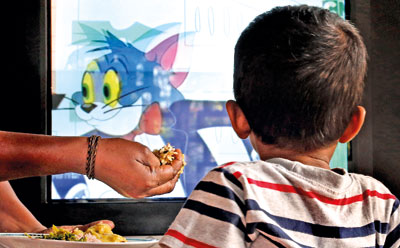Keep your child away from screens
Those were the days when parents and grandparents carried babies or toddlers all over the home and the garden in a desperate bid to feed them. Times, however, have changed and now there is an easier but unsuitable method – feeding by handing over a ‘screen’ to a little one is catching on.

Don't make meal time screen time. Pic by M.A. Pushpa Kumara
This should be a clear “no, no” reiterates Consultant Paediatrician Dr. Samanmali P. Sumanasena who is also a Senior Lecturer attached to the Disability Studies Department of the Ragama Faculty of Medicine, University of Kelaniya.“Don’t expose a child before two years to any kind of technology,” is her strong plea.
Pointing out that these screens include hand-held devices such as mobile phones, tabs and I-pads, she says another easy way out for parents is to make the child sit before the television (TV). However, there is a lot of literature across the world on the adverse impact of screen use on young children, warns Dr. Sumanasena, showing how easily ‘misuse’ of screens can take place while explaining how to use screens in a meaningful way.
With the misuse of screens having a major impact on the development of language and cognition in young children, with evidence in some countries, the United States of America and Australia have issued guidelines on screen-use, MediScene understands. Cognition is the mental action or process of acquiring knowledge and understanding through thought, experience and the senses.
Dr. Sumanasena says that with screens being part of daily living and the inevitable presence of screens everywhere, there is focus not only on the adverse impact but also recommendations on how to use them in a meaningful manner.“Brain development is best in children in the age-group 0-3 years,” she says creating the image of an area where there is no wiring at the beginning but gradually gets the wiring in place over these first three years. The brain does continue to grow after the first three years, but not as rapidly. It is in these three crucial years – from birth to 3 years – that the circuits are formed aptly and optimally in the human brain.
This Paediatrician keeps stressing that during this period it is very important for a child to interact with adults. The child evolves through adult mediation and play-based interaction is the best way of learning.She compares the two scenarios – mother vs screen.
When the child is interacting with the mother, it is like a game of tennis: Serve and return. The mother will say or do something to which the baby responds and vice versa. All these messages get stored in the baby’s brain.Turning towards the other scenario of screen and baby, she underscores that there is only serve but no return.

Dr Samanmali Sumanasena
The baby’s learning pattern is different to how we learn. Everything is new to the baby and there is a transfer of learning through true life situations. There would be a huge gap if the baby does not learn it with an adult in a familiar situation. The baby learns from everyone around him/her, whether the parents or extended family.
Older children will build a sellam-ge (playhouse), an aunt may pick flowers and thread a garland together, someone else may make sand cakes with pol katu (coconut shells) and so the games and the learning go on. When it rains, paper boats will be made and floated.
“There is a misconception that technology-based learning is best, but all research studies disagree. If you do get a child to dabble with technology, then there are strong guidelines,” says Dr. Sumanasena.
She cites the American Academy of Pediatrics which recommends no television (or screen media such as computer games, videos or DVDs) for children under 2. For children over age 2, the recommendation is 1 to 2 hours per day for television (or any screen media).
These guidelines cover different aspects:
When taking the child – different children will have different needs, depending on the age and the mood.
Content – sometimes the parent does not even know what the child is watching. If a repetitive nursery rhyme is shown, wrong pathways may be created in the brain which is like a large computer. There would only be rote learning, with the context unknown and without knowing how and when to retrieve this knowledge.
Pointing out that there is no major evidence that TV is a causative factor for autism, she says that it is, however, proven that screens reduce expression of language in children. If the child is shown a nursery rhyme, it should not be repetitive — the parent should talk about it to the child and play with the child.
Context – when the child is given a little time to watch TV, it should not be passive watching with the parent on the mobile or some other screen and the child left to his/her own devices. Then the child has no other interaction and will just be glued to the screen.
Dr. Sumanasena, having read up extensively on this important topic says that the suggestion particularly in America is to expose children to shows with a strong storyline and storybook structure (beginning, middle and end). This is while avoiding background media and switching off the TV when children are playing and during meals.
Don’t keep screens in the bedroom, she urges. Screen use before bed makes it hard for children to fall asleep and stay asleep. The bedtime routine should include stories, songs and hugs.While for babies there should be no screen time, there could be moderate use of screens for older children when doing their homework. However, don’t keep any child “occupied” with a screen.
Elaborating on autism, Dr. Sumanasena says that in clinical practice what they have seen is that even though a child may have a genetic pre-disposition to autism, exposure of such a child to screens would make it difficult to spot the early signs of autism which would prevent early intervention and better outcomes.
If the child is seated before the TV preferring screen movement, the parents would not notice that he/she is not bonding or that it is difficult to console him/her. The child can also get hooked or addicted to the screen, she says, adding that screens increase the expression of autism.
With a screen addiction will come the trauma when the child is forced by the parents to get off the screen……a vicious cycle follows.
Getting back to flaunting a screen before the child’s eyes to feed him/her, Dr. Sumanasena talks of the dangers of overfeeding children engrossed on what is happening on the screen. This could very well lead to obesity and chronic non-communicable diseases.
| Why it’s not a good idea With screens an integral part of our lives, Dr. Samanmali Sumanasena shows the way in dealing with the dangers. Never use a screen to feed a child or to make feeding time attractive. Use feeding time to teach the child about food – to smell it, taste it.Stop shovelling food into the child’s mouth – give him/her a chance to touch the food and put a little bit into the mouth. If the baby is not seated before a screen, the baby will say enough when he/she is satiated, thus preventing obesity. | |
| Importance of play Referring to the importance of play, Dr. Samanmali Sumanasena says that research has proven that the best method of learning to improve intelligence, cognition and language is play. Play can vary depending on the child’s age, MediScene learns. Very young children (till about 7-8 months) learn by reaching for toys, touching them, shaking them, putting them in their mouths and throwing them about.Older children learn by using stuff such as a cup and discussing with the parent about it with the beginnings of the use of language. What is the name of the item, eg cup? How do I use it? When do I use it? What do I name it?After about 1 year, the child will play with a collection of toys – dressing up the doll, feeding it, putting it to sleep…..all require multiple steps. Making the duck swim in water and so on. Children imitate adults. There is also role-play. Keeping a group of dolls and the child becoming the teacher, she says, pointing out that all these processes halt if the child is seated before a screen.“Spend time with your child. Play with your child. There are no short-cuts to teaching your child. Otherwise, your child will become mechanical and there will be delays in the child’s narration and analytical skills,” adds Dr. Sumanasena. |


